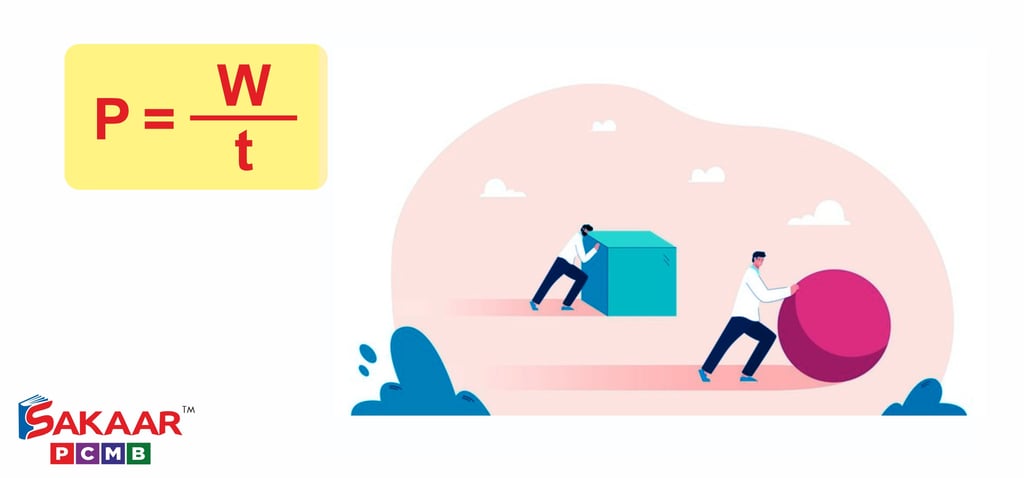Work, Energy and Power

Work, Energy, and Power are fundamental concepts in physics, serving as pillars in understanding the dynamics of the physical world. Work is the measure of energy transfer that occurs when a force acts upon an object and causes it to move a certain distance in the direction of the force. Energy, in this context, represents the capacity to do work, encompassing various forms such as kinetic, potential, thermal, and others. Power, on the other hand, quantifies the rate at which work is done or energy is transferred, expressed as the work done per unit of time. Together, these concepts provide a framework for analyzing and describing mechanical processes and phenomena in nature.
Table of Contents
What is Work?
Work Formula
Work Unit
Work Example
What is Energy?
Energy Types
Energy Unit
What is Power?
Power Formula
Power Unit
Power Example
Work, Power, and Energy Questions
Overview of Work, Energy, and Power
Frequently Asked Questions – FAQs
Definition of Work:
Work is the result of a force exerted on an object, causing motion or displacement in the direction of the force. It is characterized by the product of the force's magnitude and the distance over which it acts. Work is scalar, devoid of direction.
Work Formula:
The work done by a force is determined by multiplying the component of the force aligned with the displacement by the magnitude of the displacement. Mathematically, it is expressed as:
W=F⋅d⋅cos(θ)
Where W represents work, F is the force, d is the displacement, θ is the angle between the force and displacement vectors, and cos(θ)Fcos(θ) signifies the force component in the direction of displacement.
Work Understanding:
This formula elucidates that work arises only when there's a displacement aligned with the force. If displacement is absent, regardless of force magnitude, no work is accomplished. In summary, work is absent under the following conditions:
Zero displacement
Null force
Force and displacement perpendicularity.
This understanding underscores the necessity of both force and displacement alignment for work to occur.
Unit of Work:
The standard unit for measuring work is the Joule (J). For instance, if a force of 5 newtons is exerted on an object, causing it to move a distance of 2 meters, the work done is 10 newton-meters or 10 Joules. It's worth noting that 1 Joule equals 1 Newton-meter, which is equivalent to 1 kilogram meter squared per second squared (kg⋅m²/s²).
Example of Work:
Consider an object being horizontally pulled across a surface by a 100 N force parallel to the surface. Let's determine the amount of work performed by this force in moving the object a distance of 8 meters.
Solution: Given:
F=100 NF=100N d=8 md=8m
As the force and displacement are in the same direction, θ=0∘ (where θ represents the angle between the force and the direction of movement). Hence,
W=Fdcos(θ)
W=100×8×cos(0∘)
W=800 J [Since Cos 0 = 1]
Since cos(0∘)=1cos(0∘)=1, the work done by the force in moving the object 8 meters is 800 Joules.


Join Best Learning Program....


Frequently Asked Questions:
Q1: How are work, energy, and power related to each other?
A1: Work represents the energy required to exert a force and move an object over a distance, while power signifies the rate at which work is accomplished.
Q2: What is the unit of work?
A2: The unit of work is the Joule (J).
Q3: What is the unit of energy?
A3: The unit of energy is the Joule (J).
Q4: What is the unit of power?
A4: The unit of power is the Watt (W).
Q5: Is power a scalar quantity?
A5: Yes, power is considered a scalar quantity since it is derived from the ratio of two scalar quantities (work and time).
What is Energy?
Energy is the capacity to carry out work. It is an essential concept in physics, characterized by its ability to manifest in various forms and undergo transformations between them. One of the fundamental principles governing energy is the conservation law, which states that energy cannot be created or destroyed; rather, it changes from one form to another.
The standard unit of energy is the Joule (J), the same as that of work. Energy is pervasive in nature, existing in diverse forms, some of which include:
Kinetic Energy: Energy associated with objects in motion.
Potential Energy: Energy stored within an object due to its position or state.
Additionally, various other types of energy are present in different phenomena, including:
Mechanical energy
Mechanical wave energy
Chemical energy
Electric energy
Magnetic energy
Radiant energy
Nuclear energy
Ionization energy
Elastic energy
Gravitational energy
Thermal energy
Heat Energy
These forms of energy encompass a broad spectrum of physical processes and interactions.
Unit of Energy:
The International System of Units (SI) designates the Joule (J) as the standard unit of energy, in recognition of the contributions of James Prescott Joule to the understanding of energy.
Overview of Work, Energy, and Power:
Work:
Definition: Work is the result of a force acting on an object and causing displacement. It is calculated as the product of the component of force in the direction of displacement and the magnitude of displacement.
Formula: W =F ×d
Unit: The SI unit of work is the Joule (J).
Energy:
Definition: Energy is the capacity to perform work. It manifests in various forms, including kinetic and potential energy.
Formula: Potential energy (P.E.) due to an object's position and height is given by P.E.=mgh, where m is mass, g is acceleration due to gravity, and h is height.
Unit: The SI unit of energy is the Joule (J).
Power:
Definition: Power is the rate at which work is done or energy is transferred.
Formula: Power (P) is calculated as the ratio of work (W) to time (t), expressed as
Unit: The SI unit of power is the Watt (W).
These concepts form the foundation of understanding mechanical systems and the dynamics of energy transfer in various physical phenomena.
What is Power?
Power is a fundamental concept in physics, representing the rate at which work is done or energy is transferred. It signifies the amount of energy consumed or produced per unit of time.
Formula of Power: Power is calculated by dividing the work done by the time taken. Mathematically, it is expressed as:
Where P denotes power, W represents work done, and t signifies the time taken.
Unit of Power:
Power is a scalar quantity devoid of direction. The standard unit of power in the International System of Units (SI) is Joules per Second (J/s), which is termed as Watt (W). Watt is defined as the power required to perform one joule of work in one second. This unit is named in honor of Sir James Watt, the inventor of the steam engine.
Example of Power:
Consider a garage hoist lifting a truck 2 meters above the ground within a time span of 15 seconds. Let's determine the power delivered to the truck. Given the mass of the truck as 1000 kg, we first calculate the work done:
First, we calculate the force needed to lift the truck against gravity:
F=mg=1000×9.81=9810N
W=Fd=9810N×2m=19620Nm=19620J
Thus, the power delivered to the truck is 1308 Watts.





